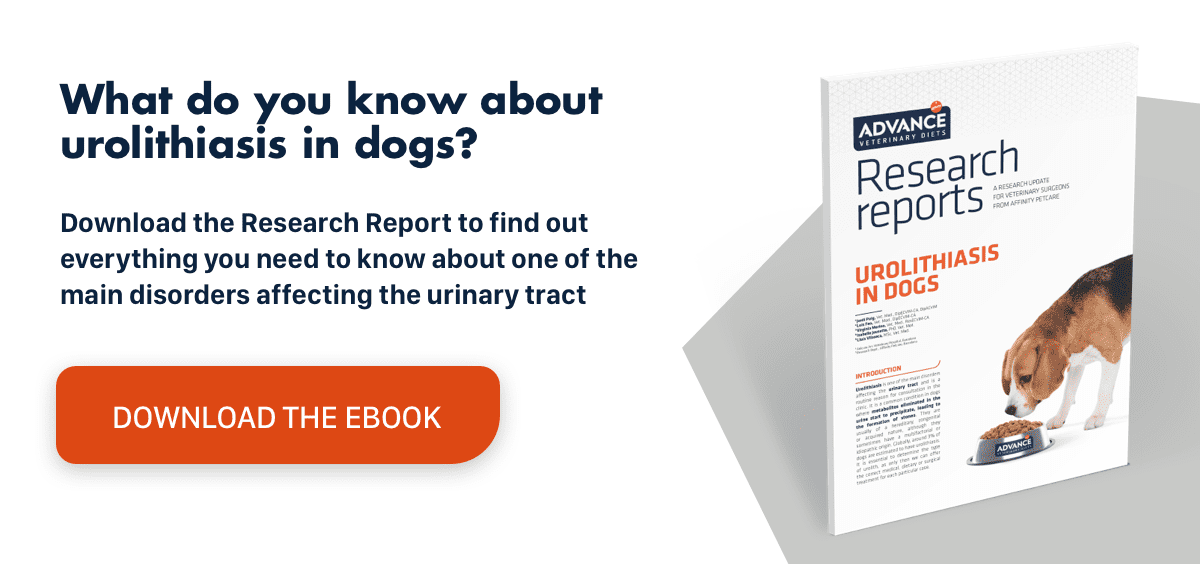Urolithiasis in dogs: a cause of blood in a dog’s urine
The presence of blood in the urine, or haematuria, is a relatively common finding with multiple possible causes, one of the most common being urolithiasis in dogs, which is responsible for approximately 18% of veterinary consultations associated with lower urinary tract problems.
Causes of urolithiasis in dogs and types of stone
Urolithiasis is characterised by the formation of sediments in the urinary tract, known as uroliths or urinary stones. Mineral salts can become supersaturated in urine for various reasons, such as metabolic problems that increase mineral excretion, a diet rich in minerals and proteins, and low in fibre, a urinary infection caused by urease-producing bacteria, or a genetic predisposition.
Whatever the cause, the result is the formation of stones in the urinary tract, 60% of which tend to be found in the bladder and 16% in the urethra.1 Their composition depends on the concentration of different minerals in the urine, although there are also other predisposing factors that can affect their formation.
According to the results obtained by Doreen M. Houston and her team2, struvite stones, which make up about 45% of uroliths in dogs, are formed from magnesium ammonium phosphate ions, and are usually associated with infections caused by urease-positive bacteria. Calcium oxalate uroliths are also fairly common, accounting for approximately 40% of all stones. They are usually caused by hypercalciuria, nephrocalcin deficiency, metabolic acidosis or a diet rich in oxalic acid.
Ammonium urate stones are also common and are formed from uric acid which is produced by the metabolism of purines found in cells and food. They have been associated with portosystemic shunts, as well as cystine stones, which are common in dogs suffering from cystinuria. Silicon, calcium phosphate and mixed uroliths may also occur, although they tend to be less common.
Diagnosis of urolithiasis in dogs, beyond the presence of blood in urine
The presence of haematuria is considered a fairly reliable sign of urolithiasis, but it is important to bear in mind that the clinical signs alone cannot be taken as a definitive diagnosis. Nor is the physical examination, as often stones cannot be palpated and although the blood count or serum biochemistry may provide information on mineral concentration or leukocyte levels, their results do not provide a conclusive diagnosis.
A urinalysis may show evidence of inflammation, haematuria, pyuria, or proteinuria, while the pH analysis provides valuable information about the type of stone, since struvite uroliths are usually associated with alkaline urine, especially in the case of urease-producing bacteria, while urate and cystine stones are associated with an acidic or neutral pH. A urine culture and antibiogram may also confirm the presence of an infection.
However, imaging studies are often required to confirm the diagnosis of urolithiasis, as revealed in research carried out by A. Frossa and N. Singh Saini.3 The first-choice techniques are radiography and ultrasound, preferably both, to determine the location, number, size, type and shape of the stones. Struvite and oxalate stones are radiopaque on X-rays, while urate stones are usually more radiolucent and often can only be detected with double-contrast cystography.
A quantitative physical analysis is a good means of studying the composition of stones, which can be collected following their spontaneous evacuation, by aspiration through a urethral catheter, urohydropropulsion, cystoscopy or surgical extraction.
Urolithiasis in dogs: treatment and prevention
The treatment for urolithiasis varies from dog to dog and depends on the type of stone. In the case of struvite stones, the ACVIM consensus4 recommends their dissolution using drugs or diets.
Advance Veterinary Diets Urinary is a specially formulated food with urine acidifying properties, thanks to its neutral pH which helps dissolve struvite stones, while also preventing their formation. It is also low in proteins and minerals such as magnesium and phosphorus, which promotes good kidney function.
Surgery is usually the treatment of choice in dogs with oxalate uroliths, as calcium oxalate stones cannot be dissolved. In such cases, diluting the urine by increasing water intake can help reduce crystal formation, as will the implementation of a low oxalate and calcium diet, such as Advance Veterinary Diets Renal, which also has a neutral pH to reduce and prevent the formation of calcium oxalate stones. The Advance Renal diet is low in phosphorus and has moderate protein and sodium concentrations to protect kidney function.
To reduce and prevent urolithiasis in dogs caused by ammonium urate and cystine stones, alkalinise the urine pH through the diet to increase its solubility. Also reduce the intake of purines found in foods such as liver and other viscera, and invest in foods with a low content of purine precursors, such as those with a high egg or vegetable protein content.

